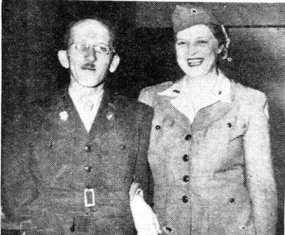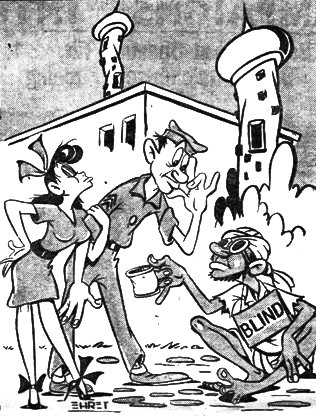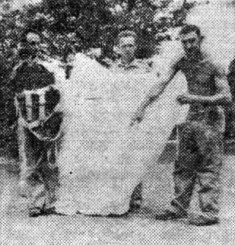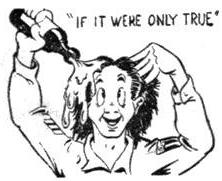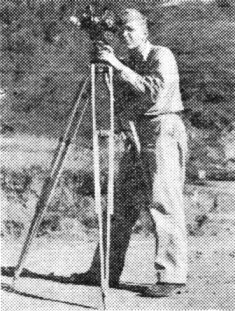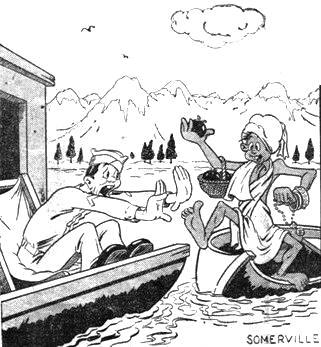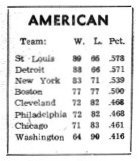
|
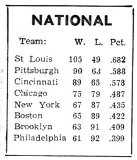
|

VOL. III NO. 4 REG NO. L5015 DELHI, THURSDAY OCTOBER 5, 1944
The B-29's are continuing their campaign for reduction of Japan's steel production, with announcement of the third raid on Anshan, industrial center in Nip-occupied Manchuria, last week by a force of over 100 bombers.
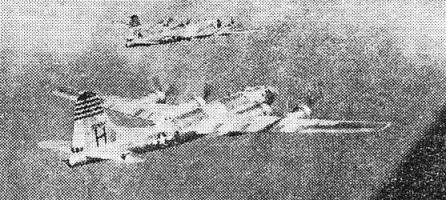
|
Enemy ack-ack fire was light and fighter opposition was meager. Not a single American plane was lost on any of the raids.
This was the first time since the B-29's began operations from the CBI in June that the size of the attack group was given by the 20th Bomber Command.
In describing the safe return of all ships, Brig. Gen. Lauris Norstad, chief of staff of the 20th, said safe return of all the planes was a "tremendous tribute" to the engineering by makers of the B-29's, their crews and ground crews at their China and India bases.
"The record of no mechanical failure should make the Japs about as unhappy as the pounding of their industries," commented Norstad. The distance covered by the huge bombers is comparable in miles to flying from Atlanta, Ga., to the Arctic Circle, Norstad added.
From Gen. H. H. Arnold, chief of the USAAF, came a congratulatory message to 37-year-old Maj. Gen. Curtis E. Lemay, commander of the 20th Bombardment Group that "the attack was a splendid military operation."
The strike at Manchuria was announced as a daylight raid from China bases.
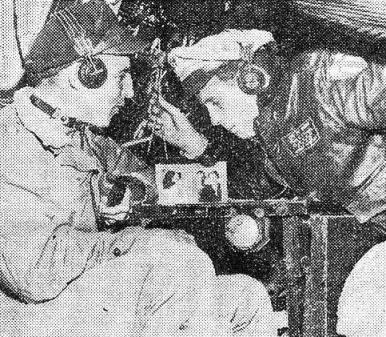
|
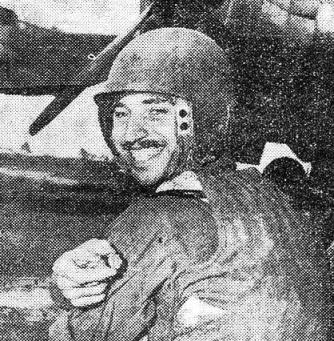
|
| The above pictures were taken during a recent B-29 mission. Left, Lt. Warren D. (Deacon) Dailey, navigator, and Lt. Tom C. Evans, bombardier, are not only crewmates but are married to twin sisters who live together in Los Angeles. Right, a man aboard Maj. Gen. Curtis Lemay's lead plane shows how his flak vest may have saved his life. |
|
|
ALONG THE LEDO ROAD - The decision has been made. An official Ledo Road shoulder patch has been selected.
Last march it was suggested that an emblem be designed for the men who have been sweating out the war in the jungles of Assam and Burma, blasting the Ledo Road through the heart of the Patkai Mountains and down into the vast Hukawng and Mogaung Valleys.
In the final stage of the contest, the entries were narrowed down to three. Each of these contained, in part, what the Shoulder Patch Committee considered the true exemplification of the Road and the men who have given so freely of their blood, sweat and tears in its construction. But none of the three was complete in itself. After long consideration, the three insignia were consolidated into the official Ledo Road shoulder patch. The resultant design has been approved by Brig. Gen. Lewis A. Pick, commanding general of the Ledo Road project, and will be forwarded to Washington for final authorization before being manufactured.
Winners of the contest, whose combined ideas have resulted in the Ledo Road shoulder patch, are T/Sgt. R. G. Powell of Atlanta, Ga., Engineers; T/4 Stewart D. Randolph of Chicago, Ill., Engineers, and T/4 Ralph B. Fuller of Minneapolis, Minn., Ordnance.
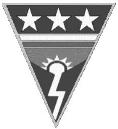
|
The patch has a basic triangular design. At the top of the triangle, red, white, and blue stripes run horizontally, with three white stars in the field of blue representing China-Burma-India. Below the stripes, a white China sun is rising between two green hills, over which winds a white road.
The patch is intended as a tribute, and in small way, a monument to the leaders who gambled their careers on a project which some people branded as a "folly" and to their men.
It is intended as a tribute to the job done by the Engineers who wound a man-made ribbon through the vitals of a wilderness which for centuries had known only the cat-like tread the Naga and Kachin huntsmen; to the Quartermaster Corps - the men who supplied food and clothing and delivered supplies and equipment through hell or high water; to the Signal Corps - the men who strung the wires which maintained vital communications and patrolled the lines through the jungle, guarding against sabotage; to the Medical Corps - the men and women who fought enemies more deadly than the Japs who lurked in the jungles; to the Ordnance Corps - the men who kept the equipment rolling, often depending upon their own ingenuity to take the place of tools and materiel they never received.
And in the final analysis, the patch is intended as a tribute to the American graves, marked and unmarked, which are the milestones from Ledo to Shingbwiyang and on to far-off Myitkyina. For the spirit of the fallen still lives. It is in the song of the tires of the big trucks which lumber up the road with endless streams of supplies for the fighting front; It is in the grim profanity of weary men battling to hold the road against encroachments of the monsoon.
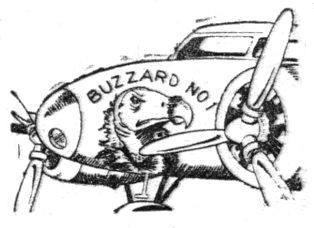
|
By T/7 OSMOSIS FINK
NORTHERN AIR SERVICE AREA COMMAND HQS., ASSAM - There is no truth to the rumor bruited about the tea gardens of the lush valley that Tingle Air Lines, Unincorporated, will be made a separate command of the USAAF. Such were the findings of this Roundup reporter, who has been ducking in and out of bashas and file cases during the past week in search of facts.
Tingle Air Lines, operated by Capt. Alvin O. Tingle, Operations Officer of this ASC headquarters, is widely-known in Assam, Burma and over The Hump. Started as a time-saver for ASC personnel during the lean years of Assam sector's tactical life, the unofficial airline has grown on the strength of its ability to serve various portions of the Allied military public.
Operating one UC-64, two C-47's, one C-46 and a B-25 "Executive Ship," the line now boasts 11 pilots, one official observer and one non-flying vice-president-in-charge-of-post-war-plans, President Tingle pointed out in denouncing rumors of dissolution and absorption by higher authority.
"We are officially credited with three Buzzards," the proud tycoon said, explaining that they had been knocked out of the skies in flight. The symbols of these victories are now painted on the nose of the Exec Ship.
During the battle for Myitkyina, Tingle Air Lines distinguished itself by flying in all of the gas used by fighters, bombers and transports from the airstrip. Some of the pilots doing this risky job were Lts. Leonard Dereszynski, Henri G. Carter, Robert M. Sines, Emory A. McCleary and Thomas E. Dailey.
Keeping Tingle Air Lines in the skies, despite bent carburetors and flapping wing-tips, are the following crew chiefs, radio operators and flight engineers: T/Sgt. Benjamin Mercer, Jr., S/Sgts. Nicholas J. DiGiovanni and Lester C. Ludwig; Sgts. King T. Powell and Speedo Tonkin; Cpl. S. W. Eskenridge; Pfc. Borce W. Love, Jr., and Pvts. Charles F. Wiersing, Gerald G. Gallant and D. W. Richeson.
As a "second team" of pilots, Tingle has signed up Cols. Russell Scott and Joseph L. Whitney, and Lt. Cols. John H. Bell, Gerald W. Crabbe and Merrill E. DeLonge. Observer Lt. Col. James H. Marsteller was accepted by a special vote of the board of directors.
Believing that Tingle Air Lines might have certain intrinsic values on the post-war market, Maj. Valdemar F. Peterson was brought in as a vice-president, who will devote his prime attention to fiscal matters and labor relations. There are problems, it seems, when for instance, Carter is ordered on flight to Agra but wants to go to a certain Burma airstrip, on which is located a well-disstaffed field hospital.
"Ours has been a tough uphill battle," the Captain-President wistfully recalled. "But we showed the world that a good independent can still stand up and trade blows with the chain-pilot, Washington-controlled organizations. Then, curiously enough, we found our competitors praising us and offering to be our pilots."
Motto of the Tingle Air Lines is "We Fly The Assam And Burma - And You Can Go Fishing En Route."
|
There are walk-out stories. Then there are walk-out stories. You recognize the distinction of course? When, searching for a missing pilot, F/O Hoyt M. Hensley and Sgt. Wilbur E. Luth crashed their training plane into a mountainside recently, their hike back to an advanced base in India was a little different, perhaps, than many other such ventures. However, Hensley's official report on the crash and his subsequent march out of the brambles with Luth is a refreshing model of informality. Taken down in shorthand by an S-2 Officer, it follows along this delightful rhetorical path:
"Sgt. Waller picked up the phone at Operations and said, "Yes," looked up and called, "Foo Hensley," Me being Foo Hensley, I answered and took the call from Capt. Kidder of Group Operations, who, it seems, wanted me to take a certain PT-17A type aircraft named Tweedle De De, over into Burma, and take a look at a 'chute hanging in a tree which might, 'he hoped,' turn out to be Lt. Blow's, who spun out, flying instruments, a few days before.
"I said okeh and walked back into the pilots' room, looked around and asked, 'Anyone want to take a ride?' Sgt. Luth, who had been detailed on a paint job, looked at the huge wall to be done and the sticky paint on his hands and, with a crafty smile, said he guessed he'd be plum glad to go along as observer. So we sailed forth, climbed into Tweedle De De, and started the little 250 horsepower radial to talking.
"By the way, I might add that Tweedle De De is the pet ship of Maj. Van Dusen, Group Operations Officer and PT instructor by trade. I might also add, in view of what happened to Tweedle De De, I still have my scalp only because a mosquito got its fangs into Maj. Van Dusen and he is still in the hospital. But woe to me when he gets out.
"Anyway, we, Luth and I, took off at 1045 hours and, very low, flew out over the rice paddies of India, and towards the mountains and jungles of Northern Burma, me flying from the front pit. On account of I don't like to look at the back of someone's head while I fly unless it's a Jap, and Luth isn't at all slant-eyed.
"We reached the target at 1145 hours and started to look for the 'chute. We found it okeh. It was on a ridge and there were two more 'chutes there also. I scratched my ear and decided to take a close look before deciding for sure that they were food 'chutes attached to bundles of food dropped by DC-3's to ground troops, who once had had an outpost there.
"As I came over the leeward side of the mountain, I felt the little ship shudder and drop. I gave her all her 250 horses and pulled up out of danger of the strong down draft, which seemed to be operating between our ridge and the next one over, which was very close. Both ridges sloped at about a 70 degree angle to meet at a little stream about 1,000 feet below. Almost a canyon with one end closed. I cut the throttle and yelled back at Luth. 'If I'm not careful with this little kite, I'll kill us both.' But he was too excited to notice as he yelled about a 'chute that had something hanging in it; big enough to be a man. All thought of the down draft was washed away by the hope it could be Blow. So back we went to take a good look this time. The 'chute was hanging about one-third of the way down the ridge on the leeward side and, as I pulled over the ridge the down draft caught the little ship, sucked he toward the trees and like a nut I was heading for the closed end of the horseshoe. I rolled into a vertical bank away from the ridge and tried to turn around, but the opposite ridge was too close. I rolled out level and tried to climb over the rim but 250 horses wouldn't do the job.
"I cut the throttle and yelled to Luth, 'We're going in,' and heard him answer, 'God's with us,' and I remember grinning and thinking, 'There's a guy with brains enough to trust in something besides his own ability,' as I gave Tweedle De De the gun, headed her for the two biggest trees that were close together, pulled the stick back in my stomach and reached for the switch. My hand never touched it. There came a rending crash and the next I knew poor little Tweedle De De was in eight pieces and the two cockpits, the biggest solid piece left, was leaning against a tree upside down.
"I was bathed in oil, gas and cold sweat, because I knew that the switch hadn't been cut. My right hand clasped the catch on the safety belt and I fell out on my head. Luth was sitting on the ground feeling himself for broken bones, having just done that same thing I yelled, "Get away! She'll burn! We both scurried about 100 feet away and turned to look back, but the dense undergrowth had already hidden the plane. We sat down to take inventory like Capt. Holley is always doing at the PX, and we found we had only one wound between us, said wound being a cut of Sgt. Luth's elbow, which I quickly washed with iodine, sprinkled on some sulfanilamide powder from our jungle packs and bandaged. Then we took out our machetes and started the slow grind of cutting our way through the undergrowth to the opposite ridge, where we knew we could find an open spot to spread our own 'chutes out so the boys could find us. The 'cute we had been looking at, incidentally, had been used for food-dropping.
"It was slow, heartbreaking work in the heat, but in about three hours we were on top of the ridge and had a 'chute spread out. In about an hour, we heard the whistle of a low-flying fighter and, sure enough, it was one of the boys looking for us. He waggled his wings and left. We wrapped up in the 'chutes and settled down to a night's sleep. The next morning we awoke, built a fire and were eating D rations when we heard the roar of heavy radial engines and looked up to see Brownie in his B-25 coming over us like on a bomb run. Sure enough down came a jungle kit with about everything from toothpicks to a blonde in it - well, almost, I said. Also there were orders from our CO to stay put and he'd see about a search party. We settled down to wait. We didn't have long to wait, for the next morning Brownie came back and dropped us orders to move out alone. We picked up our trusty machetes and started hacking by the compass toward the north, where the map showed a trail along the top of a ridge. It proved to be closer than we thought and we were soon on it heading northeast. At about this time, the rain, which had been falling in torrents, became a regular water spout and you couldn't see but about 20 feet in the dense jungle growth. It was so dark at times we would stumble and almost fall, but it was rather easy to follow the trail as it was the only opening in the leafy wall around us. We walked hard all day and toward evening we were just stumbling, head down, along the trail which had grown dim.
"We crossed a gushing river and by this knew we had lost the trail. It was nearly dark and there was nothing to do but follow the one we were now on. In about another hour, we were practically crawling up the steep slope when we came to an opening and in it was a cluster of native huts. God, what a heavenly sight. Those rough bamboo huts with smoke coming out of the sides were just that. We yelled for joy and didn't care if they were head hunters or not. They were people, anyway, and that was a vast improvement over that darned coo-coo which kept us awake the night before.
"The natives, however, proved to be very friendly and seemed overjoyed. But I wish to make a statement right now to the effect that Hollywood could be sued for libel, and how. Only one in the village could speak any English at all and his vocabulary was limited to 'My Mama Done Told Me' and 'Old MacDonald Had A Farm' in a non-musical voice, and, of course, the ever-ready 'okeh' to everything you said, no matter what.
"They fed us some rice and God only knows what boiled together and then gave us some blankets to sleep on. American blankets, by the way. We slept while our clothes dried by the fire. It was wonderful. The next morning we got up and ate more of the same ungodly stuff and started out on the trail with a young singer and a pal of his who always sang
|
"We stayed all night with some troops there and the next morning the CO took us into the nearest base, from which we phoned to our own base that we were okeh. We then caught a DC-3 back, ate a hot supper, took a cold shower and hit the hay.
"As I write this, I have not yet met Maj. Van Duesen, the proud owner of Tweedle De De, and I have a feeling the worst of this deal is yet to come. It's a good thing that flight officers are like buck privates. You sure can't bust them."
By PVT. JOHN R. McDOWELL Roundup Field Correspondent |
"Hey, Omar," Joe says. "It says here that a private in the Army receives the equivalent of $3,600 a year in civilian life."
"Listen, Joe," says Omar, "this ain't no time to be making bad jokes. Fifty sheckels, plus overseas, don't make that kind of music in my pocketbook."
"You got the wrong slant, Omar. You gotta consider things like chow and clothes and lodging and entertainment, stuff what Uncle Whiskers gives for free."

|
"Yeah," say Omar. Which means he ain't convinced.
Across the paddie in a pillbox a Jap machine-gunner sprays the horizon, and hot lead whines over Joe and Omar. Frightened birds shrill in the jungle, then all is quiet again.
"Omar," says Joe.
Omar with a mouthful of cold hash, grunts.
"It says here, too, that you also gotta consider that the civilian has gotta pay taxes, and high rents, and high prices for chow and clothing. And entertainment is taxed and liquor is sky high and hard to get."
"Yeah," says Omar, gulping down the last shred of hash. "Like to get my hands on the bastard what makes these rations. Just one."
Jap mortars open up from behind a jungled ridge on the left flank, and Joe and Omar crouch low in the rain-soaked pits and their fingers clutch at the slimy mud. Then all is quiet again.
"Says that the private, besides making the dough, is getting a balanced diet of chow what the civilians never see," Joe says.
Omar sucks slowly on the last cube of sugar from his rations and wrings muddy water from the tattered legs of his fatigues and wriggles his bare toes in the water in the bottom of the shell hole. He had thrown away his moldy, water-logged shoes the day before. "Yeah," he says.
Ka-whoomph goes a Jap 150, and a geyser of mud gushes up 50 yards away and mud and rocks rain down on Joe and Omar.
After a time, Joe says, dreamily, "3,600 kissers a year, 3,600, Jeez, Omar, I didn't never know we was so well off."
It begins to rain again. And Omar heaves the empty ration can in the general direction of the Japs. "Shed-up," he says. "Shed-up."
|
Famous Red Cross Worker Asked Assignment
FOURTEENTH AIR FORCE HEADQUARTERS - Proving that sooner or later everyone comes to China, a new celebrity has arrived here under the auspices of the American Red Cross.
"Ryan of Guadalcanal" is the title she is known by to thousands of soldiers, sailors and marines who fought in the Southwest Pacific. Her name is Mrs. Coletta Ryan and her home is staid Washington, D.C., but there isn't much that is staid about Coletta. She has been a Ziegfeld star, a sociologist, and the first woman to land on the beachhead of Guadalcanal.
It was immediately after the invasion; in fact, so close on the heels of the advancing Marines that the environment wasn't quite suitable for organizing a Red Cross club, which was Mrs. Ryan's job. She set up headquarters, nevertheless, in a thatched roof shack on the edge of the improvised American fighter strip. Next day, both field and headquarters were bombed out by the Japs, and from that time on it was tough going on Guadalcanal for Mrs. Ryan's Red Cross.
She lived in fox-holes, instructed the natives in planting and growing fresh vegetables, taught the "Black Mary's" to milk cows and saw that our fighters received all the Red Cross services that could be gotten to them.
Mrs. Ryan remained on Guadalcanal until the island conquest was completed and the jungle battleground had been transformed into a comparatively civilized supply base; then she returned to the States and asked for an assignment to China.
In Northwestern China, "Guadalcanal Ryan" will preside over Red Cross activities. The American soldiers stationed there are already impressed, though it is doubtful if they know much about her previous fame. She is tall, red-headed and personable, and has lost none of the beauty which prompted Flo Ziegfeld to give her a star role in his 1923 Follies. At that time, she introduced the memorable A Pretty Girl is Like a Melody and with that song created musical history on the Great White Way.
Previous to the war, she had been active in social work in Washington.
|
|
According to Chinese sources, one of two enemy columns attempting to by-pass Kweilin are near Kungcheng, 47 miles from the Kwangsi capital. One Nip column was reported about 12 miles from Kungcheng, with Luichow threatened by the columns which are swinging around Kweilin.
Meanwhile, Maj. Gen. Claire L. Chennault announced abandonment of the airfield of Tanchuk in South China. Tanchuk, in Kwangsi Province, is about 117 miles south of Kweilin, where the 14th was forced to abandon its major base on Sept. 17. Chinese reports amplified the Tanchuk abandonment report with a statement that Jap troops had entered the city later in the week.
Chennault, although he has lost two of his bases lately, stated this week that he was "not convinced" that "we have lost the campaign for Kweilin and Liuchow." He added that the Nips were consuming great quantities of supplies they would need later.
From Chungking cam a story that the Chinese Government is contemplating setting up a War Production Board similar to the one in the U.S. This announcement followed announcement of Donald Nelson, just returned from China, that China's industrial facilities would be increased.
‘HERDED’ JAPS TO DEATH
Decidedly unpopular with the Japanese in Northern Burma is Owen R. Allred, Captain, Air Corps., who jockeys a P-40 fighter plane of the Burma Banshees. Not content with a single spectacular feat against the enemy when the Nips still held parts of Myitkyina, Allred contributed a "doubleheader" that helped the Allied ground forces under Gen. Joseph W. Stilwell drive the disorganized remnants of their adversaries across the Irrawaddy River.
Allred, who hails from Cedar City, Utah, used to do a little cattle herding back Stateside with an airplane. So, one day not so long ago, up over Myitkyina, Allred was cruising around, preparing to bomb a noted Jap strong point, when he spotted a whole passel of Japs hiking through a communication trench, toward the fort the Allred was about to strike. He sought, and got, permission to hold his fire for a bit, and continued to circle, each time permitting a few more Japs to scamper to the "safety" of the fort. When he decided that he had herded as many as possible in, he peeled off and let them have it. A few hours later, when the Chinese forces moved in, they counted the bodies of an even 40 Japs.
As if that wasn't enough, Allred was also party to one of the most accurate jobs of pin-point bombing on the railways witnessed in CBI history. In this case, the project was to bomb five freight cars, all linked together. The target car was being used as a portable pill box.
Two flights were sent up, one for each target. One trip was all that was needed. They blasted the five cars in the one string, without even touching another car. They also snipped out the single freight car that was causing trouble to the ground troops.
Allred has been rewarded for his 440 combat hours with a DFC and two clusters, plus an Air Medal and three clusters.
|
What's In A Name?
HERE'S WHAT CHUNGKING - The inherently superstitious Japanese were uneasy with the name "Loyang" when they captured that strategic western Honan town. They promptly decided to change it because it sounded like the two Chinese characters meaning "setting sun." The town was renamed "Fuyang." Now the Japs are confronted with another embarrassing dilemma. Fuyang has the same sound as the Chinese characters meaning "captive sun." |
TENTH A.F. HQS., INDIA - T/Sgt. Edward J. McCarthy, radio operator-gunner of the Tornado Squadron, 10th Air Force, EAC, is very pleased with his parachute, despite the fact that it almost resembles Swiss cheese with 200 holes. During a mission over Burma, the sergeant felt a slight impact in his back when his plane encountered Japanese ground fire. McCarthy thought no more about it until he returned to base. Then he found a bullet lodged deeply in the silk of the 'chute. He survived with a "whole" skin, but the parachute took the count with almost 200 holes. In the photo at right, parachute riggers Cpl. Euel J. Pertect, left, and T/Sgt. Joseph F. Krul, right, examining the chute with McCarthy, center. |
 A GRISLY CHINESE TROPHY
A GRISLY CHINESE TROPHY
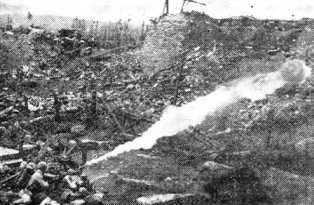 Made-in-America flame throwers in the hands of the Chinese played an important role in the reduction of the ancient
walled city of Tengchung after a siege of three months. Soldier is shown squirting flame into a Jap pillbox,
while riflemen and tommy-gunners give him protection. Heat of flame blew up grenades and other enemy ammunition
inside strong points.
Made-in-America flame throwers in the hands of the Chinese played an important role in the reduction of the ancient
walled city of Tengchung after a siege of three months. Soldier is shown squirting flame into a Jap pillbox,
while riflemen and tommy-gunners give him protection. Heat of flame blew up grenades and other enemy ammunition
inside strong points.
|
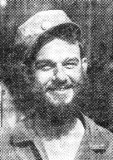 Pvt. Raymond Drzewiecki, of the Y-Force Operations Staff, hasn't shaved since the start of the Salween campaign,
won't until victory is won.
Pvt. Raymond Drzewiecki, of the Y-Force Operations Staff, hasn't shaved since the start of the Salween campaign,
won't until victory is won.
|
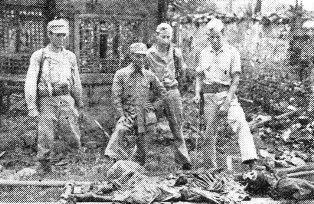 Fighting was so intense that the Japs often didn't have time to bury their casualties. So when the Chinese forces,
accompanied by American Y-Force liaison members entered Tengchung, they found this soldier who had died on a stretcher.
Left to right, Sgt. Joe Gourley, Capt. Pung, Cpl. Donald Larsen and Capt, Marshall Bennett, members of the
invading force.
Fighting was so intense that the Japs often didn't have time to bury their casualties. So when the Chinese forces,
accompanied by American Y-Force liaison members entered Tengchung, they found this soldier who had died on a stretcher.
Left to right, Sgt. Joe Gourley, Capt. Pung, Cpl. Donald Larsen and Capt, Marshall Bennett, members of the
invading force.
|
Pingka Totally In Chinese Grip; Japs Flee To Mangshih
Roundup Staff Article
Pingka is now totally in Chinese hands as the Salween Expeditionary Force of Gen. Wei Li Huang, assisted by the American Y-Forces liaison group under Brig. Gen. Frank Dorn, marked the fall of the third of the original objectives of the attacking forces who began their attempt to link up with Gen. Joseph W. Stilwell's forces in North Burma on May 11.
The Nip garrison withdrew from the city, with the aid of a relief column from Mangshi. The enemy was harassed all along the route until he reached the safety of Mangshih. One enemy column withdrawing towards Mangshih lost 60 out of an estimated 100 men to the attacking Chinese. Pingka's seizure follows the capture of Sungshan and Tengchung.
Enemy withdrawals were also reported this week from Lungling. A column estimated at between 300 and 400 was seen withdrawing towards Mangshih.
A survey of the 11th Group Army combat sector in the Lungling-Mangshih area shows that during the period from June 1 to the present the Chinese have capture 1,300 rifles, over 100 light and heavy machine guns, seven mortars and 54 knee mortars, seven trucks and a quantity of other material. During this same period 20 Japs were captured and 2,934 dead Nips were counted.
WRONG ADDRESS This was the rugged, forgotten Salween Front, where PX supplies had been rumor rather than fact. So you would have expected the G.I. trudging up the trail to have worn a smile of pleasure. For in his arms he cradled a small, rare collection of PX items, just miraculously flown over the Hump. But no, his face was a curious mixture of wonder and dejection. "Look what I won when we drew for supplies," he croaked miserably, holding up a bottle of hair oil. He swept off his cap. The rays of the sun hit and glanced off his highly-polished bald pate. |
|
BRITISH LRP HITS NIPS PAST TIDDIM HQS., SEAC - Long-range penetration forces of the 14th Army are operating in the Fort White area 12 miles south of the Jap-held village of Tiddim, it was revealed this week. This flanking move threatens the escape route to the Chindwin River of Jap troops now offering stiff resistance to the 5th Indian Division, which is moving on Tiddim from the north. In North Burma only patrol activity was reported by Maj. Gen. F. W. Festing's British 36th Division south of Hopin on the railroad and by Chinese troops near Kazu in the Myitkyina area. |
FLYING PHOTO MEN FILMED DEATH OF KWEILIN
By Sgt. GRANT ROBBINS
CHINA - T/Sgt. Harold E. Geer and Sgt. Frank W. Tutwiler were on the scene when the trouble started, and that is what photographers call luck.
They are two action-loving cameramen attached to a combat camera unit in China with the 14th Air Force. The two flying photo men were assigned by their outfit to Kweilin air base many months back to cover the strafing, bomb-spattering raids of "Flying Tiger" B-25's and fighters against the Japanese columns moving on Changsha, Hengyang, Lingling and, eventually, toward Kweilin itself.
|
By day, the sergeants flew in the low, tree-scraping raids over roads, railways, rivers and valleys, and at night they either developed film at the base lab or hitched more rides on the night attackers that blasted transportation centers in the path of the Jap advance.
News trickled into Kweilin that the poorly-equipped Chinese armies were falling back before the invader, that advance columns were approaching the city. When American units began evacuating, the sergeants realized they were on the scene of one of the most spectacular events to take place in the Far Eastern War.
In the heart of Kwangsi Province's primeval, conical hills lay the modern American bas of Kweilin, colorful in its blending of the East and West, the ancient temples and villages an the machines and installations. Soon there would be no more brightly-painted shark mouth planes flying low over the control tower, wig-wagging a signal of victory to the ground crews below; instead only barren, charred ruins would remain. Big craters would gape along the surface of what had one been runways.
Geer and Tutwiler packed their extra equipment and shipped it back to unit headquarters on an evacuation plane; then started to work furiously on the panorama of Kweilin's destruction. On the base they filmed the burying of bombs along the runways, using 16mm and 35mm motion picture cameras as well as C-3 graphics for still shots. The bombs were buried by coolie laborers, who first chalked huge circles around the holes to warn personnel on the field and pilots preparing to land. Then, at a set moment, the bombs were exploded. Gasoline was thrown over barracks and barbershop, mess and recreation halls. Rooms at headquarters were piled high with maps and broken furniture; then all was put to the torch. There was tension in the air as the G.I.'s under the command of Brig. Gen. "Casey" Vincent worked hour after hour to destroy what had been built with such great pains and cost.
Geer and Tutwiler covered it all carefully and in detail. They caught a truck to town to film the last few days of what Brooks Atkinson had called the "Paris of China." Kweilin was certainly one of the newest and most beautiful cities of Free China, but now smoke rose from the north end of town. Refugees hurried by, their family possessions slung over their backs or strapped to each end of a bamboo pole which was balanced over the shoulder. Ox-carts and rickshaws headed towards the railroad station.
Geer caught one picture as he was crossing a bridge in town. An old woman sat on a pile of luggage belonging to he family. Her bound feet could carry her no farther and the children had left he to guard the baggage while they hunted for a means of conveyance. On her ancient, lined face was the agony of the uprooted and fleeing China of the past. For seven years, it had retreated from town to town, hoping that each stop would be the last, only to be driven westward again.
At the railroad station whole families huddled together waiting for their only means of escape. Beside the platform was a pile of luggage 15 feet high. Which case belonged to what family did not matter right now; that could wait until the other end of the line. When a train pulled into the station it would be literally covered with passengers in an instant, from the cow pusher to the caboose. Pilots who have flown over these refugee trains describe them as resembling crawling white snakes from the air. The white was humanity.
The sergeants took numerous stills of the refugees at the station, and risked their lives to stay.
When the airfield was destroyed and the destruction recorded, Geer and Tutwiler packed their film and went to the next base along the line. They were among the last to depart. While they carried photographic history in their packs, for American soldiers who knew and loved hospitable Kweilin, it was a sorrowful scoop.
AN INDIAN ASSESSES G.I. JOES
This freely-contributed expression of his regard toward the G.I. Joe comes from a former staff writer of the Rangoon Gazette at a time when Rangoon was being blitzed, Jap style, and the AVG was blazing a trail of glory and heroism unparalleled for sheer recklessness and courage. Today, he is serving the U.S. Army in a stenographic-secretarial capacity, trying in his own words "to repay the debt I owe that brave young pilot" who flew him and his wife out of Myitkyina. - The Editor.
By ERNEST M. DHARMA Ex-Reporter, Ex-Rangoon Gazette
Rangoon - city of laughter and sunshine and shimmering golden pagodas; Rangoon - capital of British Burma and one-time starting point of U.S. Lend-Lease supplies to valiant China; Rangoon perhaps longer to be remembered (by the people of the United States) because of her connection with that gallant band of free-lance fighter pilots, the AVG, whose deeds of smooth and superb daring in the skies over the city were blazoned the world over.
An Indian (Sinhalese), born in this beautiful city, I was a newsman employed on the leading British-owned paper in the country and had the distinction of witnessing and chronicling the spectacular performance of these AVG aces. For some eight weeks, following the first attack on the city, Dec. 23, 1941, we generally didn't give a damn for the terrors. And why? We had come to swear by one thing, and one thing alone - the AVG. I left once-charming and vivacious Rangoon, following the general evacuation order given on Feb. 20, 1942, bomb-torn, shell-pitted and marred with ugly, gaping ruins.
Followed nine nightmarish weeks of fleeing from town to town, village to village, the while enemy airmen
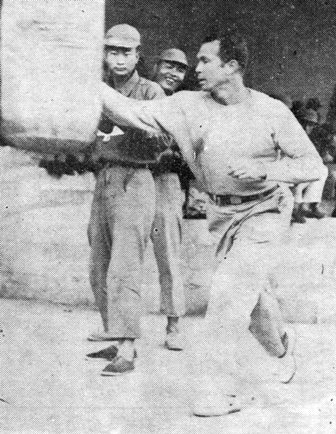 Capt. Mark Conn of Arverne, N.Y., Golden Gloves National Lightweight Champ of 1936, demonstrates a right-hand punch
to interested Chinese. Conn is attached to Maj. Gen. C. L. Chennault's 14th Air Force and contributes most of
his "off duty" time to instructing G.I.'s and Chinese soldiers in boxing techniques.
Capt. Mark Conn of Arverne, N.Y., Golden Gloves National Lightweight Champ of 1936, demonstrates a right-hand punch
to interested Chinese. Conn is attached to Maj. Gen. C. L. Chennault's 14th Air Force and contributes most of
his "off duty" time to instructing G.I.'s and Chinese soldiers in boxing techniques.
|
I rested in evacuee camps for a while and then, in October, 1942, got a job at an American Air Depot, APO 884 (Agra).
I learned what it was to "squawk," and forget all about it when the boys got around and "shot the bull" during dinner-hour. Then there was always the amusing, self-assumed superiority of the Yankee over his "rebel" brother, and the drawling, cussing contempt of the Southerner for the Yankee. Which made me conclude that the line of demarcation, if any, was very thin or just pure imagination. I would watch them (these rivals) patch up their arguments, and know that one and all they considered themselves Americans first, last and always. I learned to roll Bull Durhams, and acquired a familiarity with Americanisms.
I would often ponder on why the average G.I. squawked, groused, and squawked some more. And summing up, on what I had seen and learned of him, conclude that he is a conscientious soldier with a high sense of duty just intent on finishing his job and getting back to Shangri-La. He hates and resents most, due to his upbringing and democratic sense of untrammeled freedom, undue interference on the part of officers who do not try to understand his position. I learned that a G.I., paradoxically, loathes anything that smacks of being "strictly G.I."
I observed the average G.I.'s inordinate, overwhelming love for home and loved ones. He never fails to write home - come what may. His hard-boiled exterior cloaks the heart of a sentimentalist and, all honor to him, he is not ashamed of it. It is this love for home and loved ones, I feel, that makes him a soldier with a punch.
At the APO's where I have served to date I made firm friends. My life and work among G.I. Joes in CBI-land is something I shall never forget. I appreciate their cocksureness and their belief in themselves, and, above all else, their belief in "the good old U.S.A."
Here at this port I have met numbers of those buddies with whom I once worked. I believe they were genuinely glad to see me. Several chided me with the remark that it was high time they sent me back on "rotation." I had no answer. I told them that very soon I would be back in my home town with the U.S. Army - and, surely, that was enough.
B-29 Super-Fort Almost Lands At Nip Airfield
SUPER-FORT BASE (Delayed) - Lt. Col. Edward J. Potter, 29-year-old Super-Fort pilot of the 20th Bomber Command has revealed the story of how his bomber, deeply mired in a Chinese cornfield after a forced landing on the return from Nagasaki on Aug. 10 was recovered and flown out 13 days later on a strip improvised by thousands of coolies.
The big B-29 had spent 50 minutes over the Jap mainland target during the raid, and when the gasoline supply ran short on the flight home, Potter started looking for a place to come down. For some unknown reason - "I guess I'll never know," says Potter - they passed up an attractive concrete landing strip to choose the emergency field farther on. Later, they learned the first strip was a Jap fighter base.
WHEELS BURIED
landing the huge airplane buried its wheels out of sight in the soft dirt, leaving it apparently hopelessly bogged down. To add to the crew's troubles, Jap fighters soon afterwards spotted the grounded bomber and strafed it several times, until American fighters appeared on the scene and drove them off, destroying three.
Potter, uncertain whether he was in enemy or friendly territory and expecting to see a Jap ground patrol any minute, was greatly relieved when a Chinese coolie appeared and led him to a telephone line where he reported his plight to headquarters.
After posting a guard on the plane, the Americans were led to a house in the nearby hills where they were well fed and offered clean, comfortable beds. "It was the most welcome sight I ever saw," says Potter.
Their pleased Chinese host told them, "You are the first Americans who have ever been here." Then quickly he corrected himself, "Except Wendell Willkie."
SUMMONED TO PLANE
Potter was awakened from sleep sometime later and summoned to the airplane, where he found two Chinese major generals, the president of a railroad, thousands of coolies, some Chinese troops and an assortment of railroad ties and jacks. Despite the pilot's doubts, they were engaged in trying to get the helpless bomber out.
Two large ramps were built with railroad ties, then the airplane was slowly jacked up out of the dirt. The machine was then laboriously tugged out on a stone ramp built behind it.
The B-29 pilot asked one of the generals if any guards were posted and was staggered by the answer. "Five hundred," was the reply and 1,000 more men were backing these up, said the officer.
Potter was returned soon after to his base to report on the salvaging operations, so was not present when the big ship, considerably lightened, was finally flown off from an improvised strip and limped back to base.
"The combat crew and mechanics who were sent in worked under constant danger," said Potter, "and dived for foxholes so often it became a part of the day's routine."
Washington Now Safe From Bombs
WASHINGTON (ANS) - The Joint Chiefs of Staff have decided that Washington is not going to be bombed. Officially.
The Librarian of Congress, Archibald MacLeish, has announced that he has received permission from Chief of Staff George C. Marshall, Adm. Ernest J. King and Adm. William D. Leahy to display publicly the most prized documents of the Library - the original Declaration of Independence, the Constitution and the British Magna Charta.
He added that the permission had been granted after the conclusion that there is no likelihood now of even a token bombing.
Air Corps Captain Walks 115 Miles in 11 Days
The spectacle of a member of the USAAF walking in the line of duty is, admittedly, fairly weird, but nevertheless . . . . . Capt. Lawrence C. Paulson, an air-ground liaison officer attached to the Seventh Bomb Group of the 10th Air Force, has spent a good deal of his time hoofing about CBI.
Paulson is the ground end of that air-ground liaison and as a consequence, he finds it necessary to plough through the jungles along with the infantry. The captain has covered up to 115 miles in 11 days, all via heel and toe, which is a hell of a way for an Air Force officer to navigate. (What ever happened to that old "High Blue Yonder?")
Paulson did his trudging with full pack and, in between trudges, he pointed out likely targets to the airborne personnel. At the moment, he is back at a desk with the Seventh, but is ready to hit the road again at the drop of an Expert Infantryman Badge.
'HUMP' HAPPY C-46 GETS MORE SPEED
BUFFALO, N.Y. (UP) - The Curtiss C-46, work-horse of the flight over The Hump, has had its payload increased by approximately 100 pounds and attains greater speed now that its camouflage paint job has been removed.
The plane is now produced with an unpainted aluminum alloy finish, displacing the rough aerodynamic drag of the paint.
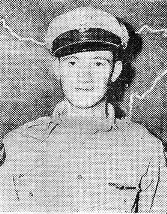
Leads The Field |
Kosteff Has Logged Over 1,000 Hours In CBI
Until it can be refuted statistically, Lt. Donald L. Kosteff, 24, a native son of Michigan who arrived in this theater with 5½ Jerries to his credit, is the claimant to the CBI test-piloting record.
Kosteff has just crossed the 1,000-hour mark and, during this time in the skies, he has waved his dhobi-white handkerchief at the undertaker in 30 different types of aircraft, including single, twin and four-motored jobs - Fortresses, Liberators, Mitchells, Lightnings, Thunderbolts, Warhawks, Mustangs, Bostons, all types of transports, and liaison ships, besides such renowned Nazi-baiters as the Spitfire and Hurricane.
The Roundup told last February of his daring exploits in aerial warfare since the days, four years ago, when he left for Canada to join the RCAF; he fought in the Battle of Britain, was downed once there but got 4½ Jerries before he took off for Africa and added a Heinkel to his credit.
Just recently, he was awarded the Air Medal for bailing out of a P-38 in flaming condition, but he stayed with her until she was safely away from a congested area where a landing would have inflicted considerable casualties.
AH, G.I. INGENUITY
THERE'S NOTHING (PRACTICALLY) A YANK SOLDIER CAN'T INVENT
Americans at home who may think the present generation of young citizens has lost the inventive genius of its pioneering ancestors, and are no longer capable of building houses with wooden pegs and the like, should take a trip around CBI.
Americans fighting the Japanese in this part of the world have invented everything from burglar alarms to electric fans, including such other luxurious articles as semi-comfortable beds, reading lamps, portable cook-stoves and means of cooling beer in a hurry.
All of which, put up against grandpa's wooden peg house, makes him look pretty much of a jerk.
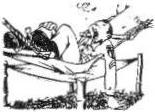
|
In the same sections, where the time of arrival of flashlight batteries is a question which is not even debated any longer, inventive G.I.'s have constructed general utility lamps, used for everything from reading to lighting oneself to bed. These lamps are made from discarded C-Ration cans, a short length of parachute rope as a wick, and a fuel, believe it or not, of insect repellant.
It is generally easy for G.I.'s to acquire small supplies of coffee. They save the little bag out of K-Rations, or they get it somewhere else. But the problem of heating the water was a stiff one until some genius invented the sand stove. The sand stove, like the lamp, is made from a C-Ration can. The can is filled with sand, and then gasoline is poured over the sand. When ignited, the stove will burn for long enough to make hot coffee. In a country where not even the air you breathe is pleasant, hot coffee is a luxury of luxuries.
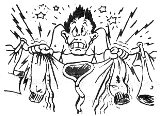
|
One burglar alarm, of a sort, was built by a unit which kept missing articles of clothing from its clothes line. The boys in the unit finally tied 220 volts to the line, which made wet drawers too hot to handle.
The electric fan was recorded in the Gremlin, published by the personnel of an air base in India. The fan is made from an electric razor. Says the Gremlin:
"The process is simple. The men simply take the razor motor out of the case, remove the cutting head, and place a paper fan blade under the screw on the spinning wheel. Then place the motor back in half the case upside down. The gadget puts out a real breeze, and is easily hung inside the mosquito net."
VETERAN 14TH CREWS DEPART FOR STATES
CHINA - A number of men in the "Flying Horse" Fighter Group, a unit of Maj. Gen. C. L. Chennault's 14th Air Force, have left for home after 32 months overseas. Thirty-two months after embarking from the United States, the men who had their orders were wandering about aimlessly, trying to realize that they had only to board a plane, fly over The Hump and the first leg of their journey would be complete.
The Group landed in India in March, 1942. The men who have gone back to Shangri-La are still telling of the amazement of the Indians, of how inexpensive jewelry was, of sending a detachment to study AVG tactics and maintenance problems, and of transferring personnel to the newly activated 10th Air Force.
BAD SITUATION
In July, the situation looked serious. Two squadrons were rushed to Assam to help stem the threatened Japanese drive into India; the third squadron went to China to replace an AVG squadron.
The Japanese were not too pleased to
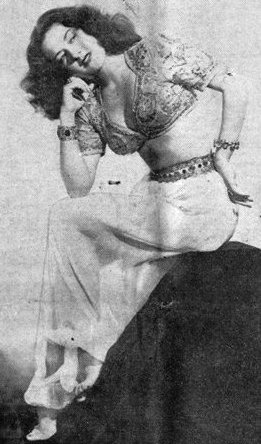 Hollywood scouts seeking a gal to play "Salome" passed up Betty Ruth Caldwell of Des Moines. We wuz robbed.
Hollywood scouts seeking a gal to play "Salome" passed up Betty Ruth Caldwell of Des Moines. We wuz robbed.
|
COMMON EFFORT
After a year and a half in India, these two squadrons joined the "Flying Wall of China" Squadron which had been in China. In China, the "Flying Horse" Fighter Group was joined by the "Lightning Tiger" Squadron, which had seen action in the Tunisian Campaign. All squadrons have been active if effectively hampering the Japs on all of the Chinese fronts.
New Club
INSIGNIA, TOO
HQ., ICD-ATC, INDIA - CBI character known as Lt. Robert E. Fillet, an aircraft type, has thought up a new switch on the fairly hoary "Late Arrivals Club."
(The "Late Arrivals Club" started during Stonewall Jackson's campaign in The Valley. The boys who couldn't stand the pace and showed up at Winchester four days late were dubbed by the wags of the day "Late Arrivals." Get it?)
Well, anyway, our man Fillet has inaugurated a CBI chapter of the "Late Arrivals" and a Calcutta jeweler is prepared to make up the insignia, same being a silver boot, with wings, for those who cracked up and walked home and a goldfish, also winged, for those who had to swim.
(The goldfish deal was originally thought up by a British manufacturer of life rafts who handed out the baubles to those who survived the English Channel dip with the aid of his raft. The boot wearers first appeared during the North Africa campaign, also among the British. Neither decoration is authorized by the War Department, but if you're entitled to one and wear it, no one seems to mind.)
The Chaplain Pitches A Strike
The Roundup hereby passes on to you a note on an on-the-ball Chaplain inserted in the Gremlin, fishwrapper published by the EM of a Service Group "somewhere in Assam" -
"Have you heard the latest rumor?"
"Honest fellows, if I had a good one, I'd spill it right now. (As, for instance: This 18-month business is the real thing.) Now there is a good rumor. - if you mean by 'good' that it will get us home sooner. But I must confess that this is only a rumor. It is unproven, untried and even non-existent.
"The things the Chaplain provides for you in this group are not rumors - history and experience have proved them true and needful. If you are tired of just rumors, why not have a change to things that are REALLY TRUE?
"ATTEND CHURCH THIS SUNDAY."
14th Air Force Pounds Enemy In Dark Hour
Roundup Staff Article
CHINA - Driven from four of their East China bases in recent weeks by the threat of the advancing Jap armies, 14th Air Force planes used other fields this week to continue their aerial thrusts at the invaders, driving for Kweilin.
B-25's led the attacks on Jap columns moving on the abandoned city along the two main highways from the northeast and southeast, strafing motor convoys, troop concentrations and supply dumps in the Chuanhsien and Tanchuk areas. Allied planes were unopposed by Jap airmen over the battle area.
JAPS DOWNED
Liberators raiding Samshui, near Canton on the West River, met 15 to 20 enemy fighters, but escorting P-51's destroyed two, with one probably downed and two damaged without loss to themselves. American fighters in a surprise raid on Hoshan airdrome near Amoy wrecked five Jap planes aground while P=38's destroyed eight enemy aircraft in a sweep over Bhre field in Thailand.
Tien Ho and White Cloud airdromes at Canton were hit twice at night by B-25's and once by heavies, catching Jap planes landing at White Cloud on one occasion.
WHALER SPLASHED
Sea-ranging B-24's sank a 15,000-ton Jap whaler factory-ship near the Pescadores Islands in a continuation of the shipping attacks which this week brought the 14th a special radioed commendation from Gen. H. H. Arnold.
Said the message: "Your personnel - ground and air crews alike - consistently have set an example of efficiency and gallantry to all other units of the AAF, but in your special operations against Japanese shipping they have outdone themselves . . . Convey my personal appreciation and congratulations to all who share in the responsibility for this outstanding job."
Air-Droppers Given DFC’s
Distinguished Flying Crosses were awarded to 60 members of the Quartermaster Air Dropping unit recently in recognition of their splendid work in providing much-needed supplies to advance Ledo Road troops and to Gen. Joseph W. Stilwell's forces in Burma.
Working alongside Air Corpsmen of Troop Carrier squadrons, the "Food Bombardiers," as they are called, have risked their lives in "over 60 combat missions," shoving supplies to ground troops in isolated areas.
First recognition was given the Quartermaster flyers - most of them former truck drivers back in the States - shortly after the unit was organized last year.
Men who received the DFC recently were:
Capt. George T. Oakley; S/Sgts. Frederick L. Winzeler, Ignatius P. Osaben, William J. Bottoms; Sgt. Edwin J. Marshall; T/4s Herman J. Dykstra, Clifford V. Beckendorf; Cpls. Floyd C. Young, Edward M. Szecepanski, Earl F. Shockley, Lloyd C. Robbins, Henry J. Robbins, Ernest B. Read, Dewey D. Popa, William Hols, John J. Dage; T/5s Lawrence E. Abare, Clifford L. Allen, Ernest C. Brine, John Budrick, Chester Davis, Stansilas S. Del Sardo, James A. DeStefano, Andrew D. Fedak, Herbert F. Frost, Spencer D. George, John Hixenbaugh, Edward Hnidder, John F. Kasperzyk, Archie Kuhn, C. Martin, John Modesta, Harold A. Myers, Thomas A. Myers, Donald E. Niemad, Carl P. Reynolds, Wilbur W. Rhue, Joseph E. Stockbauer, Edward W. Trott, Peter P. Ulius, Russel O. Young; PFCs Lorin A. Parsons, Willis W. Myers, Harvey S. Gough, Thomas J. Heston, Charles S. French, Clifton W. Cryer, Robert M. Branstetter, Charles E. Boyce, Jr., John A. Bates; Pvts. Allen F. Lentz, Dewey E. Lilly, Paul D. Lowery, Edward J. Klimasara, Harold Jastrow, Jefferson F. Johnson, Norris Johnston, Carl K. Fischer, Thomas B. Barber and Luther H. Aleshire.
|
Eastern Air Command aircraft sharply stepped up the pace of their operations last week.
RAF and USAAF bombers and fighters ranged throughout Burma from the Chinese border to the Martaban Gulf, preying upon Japanese lines of communications and strong points.
RAF Liberators of the Strategic Air Force scored excellent results on a mission against the railroad workshops and railway sidings at Myitnge, south of Mandalay. The Libs also attacked the railway yards at Mandalay.
VARIOUS TARGETS
Mitchells of the 10th Air Force operated against various targets in Eastern Burma. On one mission, the principal anti-aircraft positions at Hsenwi, important junction on the Burma Road, were silenced prior to an effective low-level attack on three bridges near the town. These aircraft also bombed the military areas at Namhkam, possibly destroying a Japanese headquarters, and followed this by a raid against Hinglong, where fire and large secondary explosions were later observed.
Thunderbolts of the 10th were extremely active throughout the week. On one mission they blew the center section of a bridge near Namma, on the Mandalay-Myitkyina railroad, into the water. The next day the dive-bombers bombed Pinlon, knocked out the south span of the Manyut Bridge and attacked bridges south of Myothit at Pinwe and Mawhun. Several buildings including the railroad station, were destroyed at Haingtion.
SHOP LEVELED
Two days later, the Thunderbolts leveled a repair shop at Wanling and exploded a fuel dump at Chefang. Myothit, Pinwe and Bhamo were attacked on numerous occasions.
Mitchells of the Third Tactical Air Force also attacked targets on the Salween front causing many fires and explosions in Wanling and Mangshih.
In Northeast Burma Thunderbolts, Hurricanes and Spitfires of the Third Tac continued their attacks against Jap lines of communication on the Tiddim Road, in the Kahaw Valley and along the Chindwin River. In Central and South Burma, long-range RAF Beaufighters were extremely effective against locomotives, rolling stock, motor transport and assorted rivercraft.
|
Or A G.I. Visit To Kashmir
by S/Sgt. KARL PETERSON
Passionately-painted travel posters bannering "Visit Kashmir" in huge letters have long leered in vain at American troops in this Theater, but a G.I. who is eligible for leave can now spend a furious furlough in the storied Vale by making the few necessary arrangements, and what can beat languishing beside the Shalimar for a few days, even if you have no other pale hands than your own to hold?
One enters the lovely Kashmir Valley, surrounded by the craggy, snow-capped peaks of the Himalayas, along a mountain road which overlooks the raging torrent of the Jhelum River. Cruising around the sharp narrow curves with the Indian bus driver taking one hand off the wheel to honk his horn, passengers who have been fortified with gruesome anecdotes of recent accidents by the local residents cover their faces and mentally reckon their insurance premiums.
Lying outside British India, Kashmir is a semi-independent State ruled by a Maharaja who has more lettuce than a rabbit hutch. He has his own army, including a horse guard of zoot-looking lancers who practice at jumping barriers and sabering straw dummies a la Crimea 1856. he has a private airfield, a modern eight-year-old palace which covers the side of a mountain, and a summer house on the lake connected to shore by a laboriously dredged-up causeway.
Passing through the Kashmir customs, you are limited to one bottle of "spirit," 200 cigarettes and three guns; further stockage in these departments is dutiable. When the man asks if you have anything to declare, this is what he means, and he is not asking for an opinion of the trip. Some of the answers in the past have been lulus.
In the capital city, sunny Srinagar, surrounded by lakes and stately poplars, you find all hotels full and end up tenting on the old camp ground in some hostelry yard under canvas set up to accommodate the overflow. After two nights of shivering insomnia in the low mountain temperatures, you transfer to a houseboat on a conveniently located lake just two hours boat-ride from town.
Here, with five rooms, four servants, a sun deck and a well-fitted little cook boat riding out back you can fairly take it on the plush. Just relax in your easy chair, gaze out at the lakes and mountains, and holler at the bearer for tea.
Houseboat bathrooms feature running water, but it's the bhisti, or water bearer, who comes running, with the stuff in a pail. Bathing in the narrow confines of a tin "Grandma" tub in two inches of tepid water is a neat trick; the secret is not to try to immerse yourself by contortions. A friend of ours, thus engaged, got over on the back of his neck once and would have drowned but for the timely arrival of a sweeper who had come to haul another load away.
The Kashmir lakes contain more pirates than the Spanish Main in the lushest days of Edward Teach, the infamous "Blackbeard." These are the shikara-wallahs, boatmen who operate the narrow, covered gondolas which serve as water taxis. Each one is romantically fitted out with bright-colored side curtains and a broad cushion for the passengers, while overhead a sign carries the boat's name and the invariable commercial: "Garden of Heaven - best spring seats." The published schedule of fare rates never worries these modern buccaneers, whose screams for more money resound through the quiet of the valley.
Their cousins, the waterborne hucksters of the Himalayas, ply the waters with fruit, candy, flowers and even furs piled high in their boats, and with the slightest smile from a houseboat resident they gleefully swarm aboard in best skull-and-bones tradition.
Others with eyes on your rupees are Kashmir's artful artisans, the wool weavers and walnut carvers, who do business under such snappy names as "Suffering Moses," "Cheerful Chippendale," and "Walnut Willie." G.I. curio buyers are advised by the local Provost Marshal to make no deposit-down-and-future-delivery deals, as some optimists in the past who thought they were getting woolens got fleeced instead.
The thoughtful P.M. also wards against the "country liquors" thereabouts. Bottled in familiar bottles with the suggestive tags of "Black Horse" and "Green Label," these dainty potions produce on successive drinks (a) twitching muscles in the face (b) lockjaw, and (c) total blindness.
You'll return to hear friends say enviously, "My, how brown and dissipated-looking you are!"
The C.B.I. Roundup is a weekly newspaper published by and for the men of the United States Army Forces in China, Burma, and India, from news and pictures supplied by staff members, soldier correspondents, the United Press, OWI and Army News Service. The Roundup is published Thursday of each week and is printed by The Statesman in New Delhi, India. Editorial matter should be sent directly to Capt. Floyd Walter, Headquarters, U.S.A.F. C.B.I., New Delhi, and should arrive not later than Sunday in order to make that week's issue. Pictures must arrive by Saturday and must be negatives or enlargements. Stories should contain full name and organization of sender.

OCTOBER 5, 1944
Adapted from original issues of CBI Roundup shared by Miriam Burrows and Linda James
Copyright © 2009 Carl Warren Weidenburner
TOP OF PAGE PRINT THIS PAGE ABOUT THIS PAGE SEND COMMENTS
PREVIOUS ISSUE CLOSE THIS WINDOW NEXT ISSUE
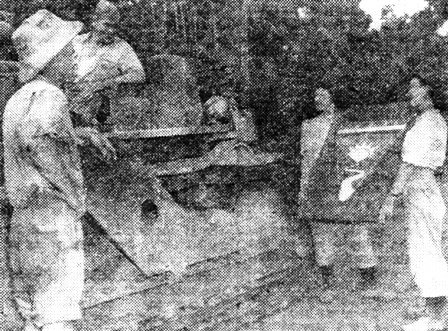 Red Cross girls Judie Astie and Audery Edmonds show the new Ledo Road shoulder patch to bulldozer operators T/4's
Lawrence M. Godfrey and Don Newell.
Red Cross girls Judie Astie and Audery Edmonds show the new Ledo Road shoulder patch to bulldozer operators T/4's
Lawrence M. Godfrey and Don Newell.
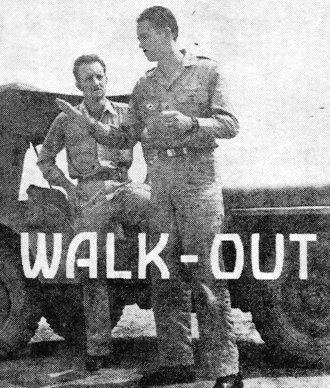 F/O Hoyt M. Hensley explains to Sgt. Wilbur E. Luth how their training plane "mushed" into the side of a mountain
while they were flying in search of a lost fighter-bomber pilot.
F/O Hoyt M. Hensley explains to Sgt. Wilbur E. Luth how their training plane "mushed" into the side of a mountain
while they were flying in search of a lost fighter-bomber pilot.
